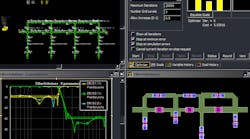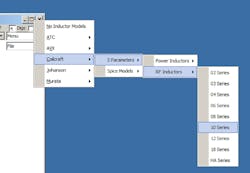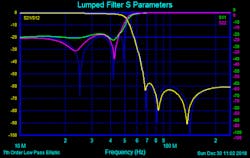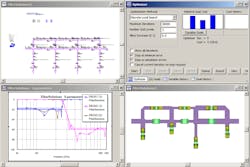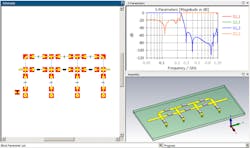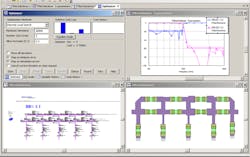Complete Filter Design with Discrete Elements Made Easy
Download this article in PDF format.
In an era of a myriad of design tools developed to “save” the filter designer time and effort, it’s exactly time and effort that may be lost due to learning curves, cumbersome workflows, and limitations of the design process itself. Powerful design tools may thus be rendered effectively useless by any one of these problems.
For example, a tool that provides powerful synthesis may fall short when the output fails to be in a realizable form, or when users find the design process too cumbersome to waste time on. Furthermore, at higher frequencies, parasitic effects become increasingly difficult to manage, and countless hours may be wasted in the hardware lab if inadequate software is used.
Fortunately, design tools do exist that overcome these limitations. Specifically, Nuhertz Technologies offers FilterSolutions, which applies the best-suited manufacturer or internal parts model automatically selected from a user-customizable database, such as the NI AWR software device library, Dassault Systèmes’ CST Studio Suite device library, or the Modelithics CLR Library within the NI AWR Design Environment platform.
For user-customizable libraries, users merely need to select a parts family, which may be custom built or supplied by the manufacturer(s). FilterSolutions then completes the design process. In the case of higher frequencies (typically above 200 MHz), FilterSolutions exports directly into the NI AWR or CST Studio Suite design environments for interconnect simulations and further optimizations. Accurate lumped-element designs at very high frequencies may be quickly realized when using FilterSolutions with the NI AWR software and Modelithics. With the CST Studio Suite, other 3D features like the enclosure and connectors could be further added to the model.
Internal Part Libraries
For low-frequency designs (typically below 200 MHz), automated part selection generally involves just simply selecting the part family from a directory of S-parameter and/or Spice model libraries supplied by the manufacturers and/or created by the user. Nuhertz’s patent-pending process employs easy-to-use pop-up menus of part families that make the learning curve negligible, enabling new users to quickly create accurate lumped designs with discrete parts.
Interconnect parasitics may be neglected initially, while the design accuracy is achieved by selecting a parts family with traits suitable for the design environment. Individual elements may be adjusted via a left-mouse click to individually select part families or S-parameter or Spice model files of specific parts (Fig. 1).
1. This is a 7-pole Elliptic example with Coilcraft 1008 Series S-parameter inductors and Murata 0603 temperature-compensating Spice model capacitors.
Coilcraft Filter Designer
For simple low-order Elliptic filters, Coilcraft’s Filter Designer offers discrete-inductor-element-designs from Coilcraft libraries. It’s freely available from the Coilcraft website. Coilcraft inductor samples may be obtained directly from the results screen.
NI AWR and CST Studio Suite Software Libraries
Users can directly export lumped filters designed with discrete elements from user libraries into NI AWR or CST Studio Suite. In addition, those using these Nuhertz partner tools may take advantage of the respective device libraries for high-frequency discrete-lumped-filter design. Use of the NI AWR Design Environment platform, specifically the Microwave Office software and the AWR website or MWO Vendor Local libraries, and the CST Studio Suite device library, is highly advantageous due to accurate and high-frequency simulation capabilities provided by microstrip interconnects. Interconnect geometry may be further optimized to achieve a closer match to design requirements.
Similar easy-to-use pop-up menus in the FilterSolutions export panel allow for selection of NI AWR, CST Studio Suite, or part family. FilterSolutions then exports the model that most closely matches the design value into the NI AWR or CST Studio Suite software, which is where the optimization goals are set up to enable the user to quickly optimize interconnect geometry as needed.
Furthermore, high-frequency lumped designs that require electromagnetic (EM) simulations for accuracy may be exported directly into NI AWR software, specifically the AXIEM 3D planar EM simulator or any of the NI AWR software partner EM simulators. These designs can also be exported into the CST Studio Suite software, where the 3D packages can be specified for the full-wave simulation model.
2. Shown is a 250-MHz and pole Elliptic discrete-filter design with the NI AWR software web library and Coilcraft 1008 Series inductors and AVX Accup-0603 capacitors.
Optimization goals may be easily adjusted as needed in NI AWR and CST Studio Suite to obtain desirable results. One way to manually compensate for interconnect parasitic effects at higher frequencies is to design at a slightly higher frequency than the design requirements. One can then adjust the optimization goals down to the desired design frequency to obtain a reasonably close match between the initially designed filter and the required design frequencies. In the NI AWR software, the FilterSolutions export panel may automate this down-frequency adjustment (Fig. 2).
CST Studio Suite Filter Designer 2D
In CST Studio Suite, Filter Designer 2D provides a seamless workflow for the design of lumped-element filters, with the underlying technology based on Nuhertz software. Once a filter is synthesized, the fully parameterized model is built in the CST Studio Suite schematic environment from which further analysis can be triggered. A 3D model is automatically configured by the System Assembly and Modeling, and it may include the package footprint of each lumped component. A range of full-wave EM solvers are available for either frequency- or time-domain analysis, while the optimizer can be setup with either S-parameter masks or the recently introduced coupling matrix extraction technique (Fig. 3).
3. This screenshot depicts a 250-MHz 7-pole Elliptic discrete filter design in CST Studio Suite using the device library with Coilcraft 1008 Series inductors and TDK capacitors.
Modelithics Library in NI AWR Design Environment
The easiest and most accurate method to design filters with discrete lumped elements is to use the Modelithics CLR Library of accurate part-value and substrate-scalable models in the NI AWR Design Environment framework. Modelithics employs exceptional and highly scalable (and therefore tunable) modeling accuracy.
FilterSolutions takes advantage of the Modelithics/NI AWR software interface to set up discrete optimizers that very rapidly zero in on the best overall choice of Modelithics models for each lumped-filter element. It then sets the interconnect optimization flag in the NI AWR software so that the user can optimize the interconnect geometry. Accurate, discrete multi-gigahertz lumped-element filter designs may be realized very rapidly using Nuhertz together with Modelithics and the NI AWR Design Environment software.1
4. This is a 1-GHz, 9-pole Elliptic filter designed with discrete lumped elements using FilterSolutions with the Modelithics CLR Library models and NI AWR software.
For higher-frequency designs (i.e., above 1 GHz), the AXIEM 3D planar EM simulator may be employed to analyze detailed EM effects. It may also be used for extraction optimization, if necessary (Fig. 4).
Jeff Kahler is Technical Director at Nuhertz Technologies.
Reference
1. I. Delgado, L. Levesque, L. Dunleavy, and J. Kahler, “Synthesize Filters with Wideband Success,” Microwaves & RF, July 2014.
